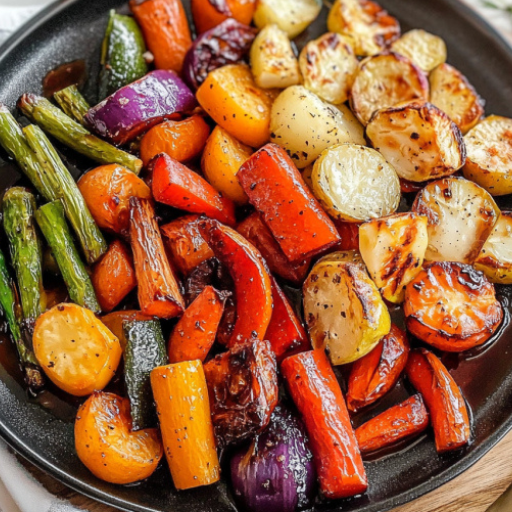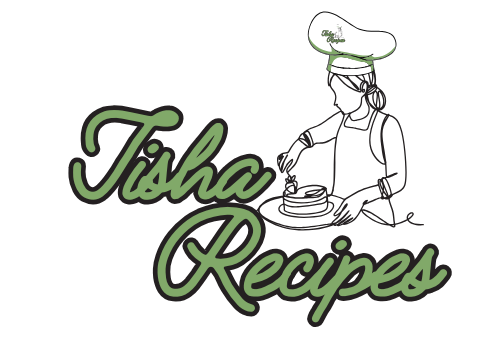
Balsamic Roasted Vegetables are a delightful and flavorful dish that can easily become a staple in your meal rotation. This recipe emphasizes the natural sweetness of vegetables, enhanced by the tangy depth of balsamic vinegar.
Roasting vegetables is a cooking method that dates back centuries, offering a perfect way to caramelize the natural sugars found in vegetables, thereby enhancing their flavor and texture.
The balsamic vinegar used in this recipe not only adds a beautiful glaze but also imparts a unique tang that balances the sweetness of the roasted vegetables. This technique has been popularized in recent years due to its simplicity and the robust flavors it can produce.
Whether you’re preparing a side dish for a family dinner or a festive occasion, these Balsamic Roasted Vegetables are sure to impress.
They are not only easy to prepare but also pack a nutritious punch, making them a go-to option for health-conscious individuals. Enjoy the medley of colors and flavors that these vegetables bring to your table, all while knowing you’re serving a dish that’s as nourishing as it is delicious.
Ingredients for Balsamic Roasted Vegetables
-
- 2 cups chopped carrots
- 2 cups chopped bell peppers (any color)
- 2 cups zucchini, sliced
- 1 large red onion, cut into wedges
-
- 1 cup cherry tomatoes
- 1/4 cup balsamic vinegar
- 2 tablespoons olive oil
- 2 cloves garlic, minced
- 1 teaspoon dried thyme
- Salt and pepper to taste
Instructions for Making Balsamic Roasted Vegetables
-
- Preheat your oven to 425°F (220°C).
- In a large bowl, combine the chopped carrots, bell peppers, zucchini, red onion, and cherry tomatoes.
- In a small bowl, whisk together the balsamic vinegar, olive oil, minced garlic, dried thyme, salt, and pepper.
- Pour the balsamic mixture over the vegetables and toss to coat them evenly.
- Spread the vegetables in a single layer on a large baking sheet lined with parchment paper.
- Roast the vegetables in the preheated oven for 25-30 minutes, stirring halfway through, until they are tender and lightly caramelized.
- Remove from the oven and serve warm.
Nutritional Information
Balsamic Roasted Vegetables are not only a treat for the taste buds but also provide a wealth of nutrients. These vegetables are rich in dietary fiber, vitamins, and minerals, contributing to a balanced and healthy diet.
Carrots, for instance, are an excellent source of beta-carotene, an antioxidant that the body converts into vitamin A, essential for skin health and vision. Bell peppers add a significant amount of vitamin C, which is crucial for immune function and skin health.
Zucchini, low in calories, provides vitamin C, potassium, and antioxidants that are beneficial for overall health. Red onions and cherry tomatoes further enhance the dish’s nutritional profile with their anti-inflammatory properties and lycopene content, respectively. Olive oil, a key component of the Mediterranean diet, provides heart-healthy monounsaturated fats and antioxidants.
Finally, balsamic vinegar, containing acetic acid, has been linked to improved blood sugar control and digestive health.
Combining these vegetables with the rich flavors of balsamic vinegar not only makes for a delicious dish but also a healthful one.
Cooking Tips and Variations
When making Balsamic Roasted Vegetables, consider a few tips to enhance your dish. First, ensure uniformity in cutting your vegetables; this helps them cook evenly. You can also experiment with different vegetables such as Brussels sprouts, sweet potatoes, or asparagus, depending on the season or your taste preferences.
Adding fresh herbs like rosemary or basil after roasting can further elevate the flavors. If you prefer a bit of heat, a pinch of red pepper flakes can add a delightful kick.
For those who enjoy a bit of sweetness, consider adding a tablespoon of honey or maple syrup to the balsamic mixture. Another variation is using flavored balsamic vinegars, such as fig or raspberry, to add a unique twist to the recipe.
If you need to prepare the vegetables ahead of time, you can marinate them in the balsamic mixture up to a day in advance, which will deepen the flavors. Lastly, don’t overcrowd the baking sheet, as this will cause the vegetables to steam rather than roast.
Using these tips, you can customize your Balsamic Roasted Vegetables to suit your palate and occasion.
Serving Suggestions
Balsamic Roasted Vegetables make a versatile dish that can be served in various ways. As a side dish, they complement a wide array of main courses, from roasted chicken to grilled fish or a hearty beef tenderloin.
The vegetables can be served warm as a bed for roasted meats or mixed into cooked quinoa or couscous for a light and nutritious meal. Additionally, these vegetables can be incorporated into salads; simply toss them with fresh greens and a sprinkle of feta cheese for a delightful lunch option.
If you’re hosting a gathering, consider serving them as part of an antipasti platter alongside cured meats, cheeses, and olives. For a casual weeknight dinner, stuff them into pita bread with hummus for a quick vegetarian meal.
The possibilities are endless, and their vibrant colors and rich flavors can enhance any presentation, making them a favorite at both family dinners and festive occasions.
Balsamic Roasted Vegetables Health Benefits
Eating Balsamic Roasted Vegetables offers numerous health benefits, making them an excellent choice for those seeking nutritious meals. Vegetables are naturally low in calories and high in fiber, which aids in digestion and promotes a sense of fullness.
The assortment of vegetables used in this dish provides a range of essential vitamins and minerals. For instance, the beta-carotene in carrots supports eye health, while the vitamin C in bell peppers boosts the immune system.
Red onions and zucchini contain phytonutrients with antioxidant properties, which help protect the body against oxidative stress. Balsamic vinegar, beyond adding flavor, has been associated with various health benefits, including improved blood sugar regulation and digestive health due to its acetic acid content.
Olive oil, a staple in this recipe, is known for its heart-healthy monounsaturated fats and antioxidant properties. By incorporating these vegetables into your diet regularly, you can enjoy a host of health benefits while indulging in a delicious and satisfying dish.
FAQs About Balsamic Roasted Vegetables
Can I use frozen vegetables for this recipe?
Yes, you can use frozen vegetables if fresh ones are not available. Make sure to thaw them and pat them dry before roasting to prevent excess moisture.
How can I store leftover Balsamic Roasted Vegetables?
Store any leftovers in an airtight container in the refrigerator for up to 4 days. Reheat them in the oven or a pan to retain their texture.
Can I add other spices to the recipe?
Absolutely! Feel free to experiment with spices such as cumin, paprika, or Italian seasoning to add different flavor profiles to your vegetables.
Balsamic Roasted Vegetables are a simple yet flavorful dish that can enhance any meal with their vibrant taste and nutritional benefits. Easy to prepare, they offer a great way to enjoy a variety of vegetables all at once. Whether served as a side dish, part of a main course, or incorporated into salads and grains, these roasted vegetables are sure to delight your palate and nourish your body. With the tips and variations provided, you can customize this dish to suit your taste and dietary preferences. By including these vegetables in your meal repertoire, you are choosing a dish that is both delicious and healthy, perfect for every occasion.




Leave a Comment